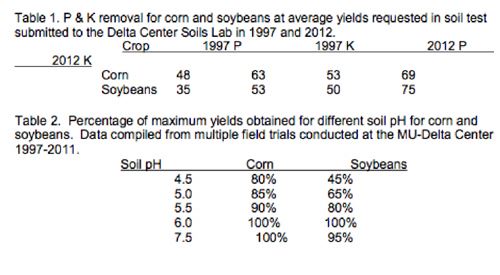Corn And Soybeans Are Different
PORTAGEVILLE, MO.
Corn and soybeans are commonly grown in a 1:1 rotation in Missouri. This practice has several advantages over continuous corn or soybeans. These include pest control, nitrogen fertilizer management, and overall soil health. While both crops of this rotation have similar nutrient requirements there are several differences that are important to consider when making management decisions. These differences are philosophy, changing yield goals, P & K crop removal and response to lime.
In the past producers have “grown” corn and “planted” soybeans. This philosophy implies that most of the producers management effort is devoted to corn and the soybeans are largely left to fend for themselves. This may have made sense with the value of the corn crop being much greater than the soybeans. But as soybeans have increased in value producers are beginning to “grow” soybeans. This intensified management effort has lead to increased yield potential for Missouri soybean crops. In the past 15 years the average yield goal requested by Missouri soybean producers on soil tests has increased from 35 to 50 bushels per acre. For corn, in the same time period, yield goals have increased from 190 to 210 bu/a. That’s a 40 percent increase for soybeans compared to a 10 percent increase for corn.
The increasing yield of a soybean crop has implications for soil fertility. The old practice of feeding the corn crop and letting the soybeans get by on the left over’s needs to be reevaluated. While soybeans do not require nitrogen fertilizers they are heavy feeders of phosphate & potash. Soybeans will remove a pound of phosphate and a pound and a half of potash per bushel of grain. Corn by contrast removes about 1/4 to 1/3 pound of each nutrient per bushel. In days past, the much higher yields for corn lead to greater removal of P & K per bushel. But as average soybean yields have increased; now the soybean crop removes about the same amount of P and a much greater amount of K (Table 1). Now consider an intensively managed soybean crop with a 75 bu yield, that’s 75 lbs of P and 112 lbs of K going out with the crop. The cost to replace these nutrients is over $100!
Another important difference between corn and soybeans are their response to P & K fertilizers. I complied all of the yield data for corn and soybeans for P & K trials from my time here at the Delta Center. The yields for each trial was expressed as a relative yield with 100 percent being the yield obtained when the soil test recommended amount of P & K was applied. This allowed me to compare years where weather conditions affected 5yield potentials. With no applied P & K fertilizer I obtained 85 percent of the corn and 70 percent of the soybean maximum yields. When I applied 2/3 of the recommended rate of P & K the yields increased to 95 percent for corn and 90 percent for soybeans. From this data it’s clear that the penalty for being low in P & K is greater for soybeans than corn.

Corn and soybeans also differ in response yield to lime. Both crops have the same preferred soil pH, 6.0-6.5. When I did the same type of comparison for lime and soil pH as I did for P & K I found that for the same pH below 6.0 more yield was lost for soybean than for corn (Table 2). Also there was soybean yield penalty for at high pH. This is due to decreases micro-nutrient advisability, particularly Manganese at pH above 7.0.
Soybeans are different than corn. By recognizing the key differences in fertilizer needs and crop removal, along with soil pH preferences producers can maximize their profits in a corn/soybean rotation. Δ
DAVID DUNN: Supervisor, Soils Testing Lab, University of Missouri